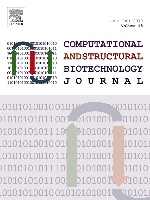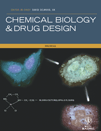
COMPUTATIONAL BIOLOGY AND CHEMISTRY
Scope & Guideline
Advancing Research at the Intersection of Life Sciences and Computational Methods
Introduction
Aims and Scopes
- Computational Drug Design:
Research in this area emphasizes the use of computational methods for the design and optimization of small molecules and biologics, particularly in drug discovery and development. - Bioinformatics and Genomics:
This scope covers the application of computational tools to analyze biological data, including genomic sequences, transcriptomic data, and proteomics, facilitating the identification of biomarkers and therapeutic targets. - Molecular Dynamics and Simulations:
The journal publishes studies that utilize molecular dynamics simulations to understand the behavior of biomolecules and their interactions, providing insights into mechanisms of action and stability. - Machine Learning and AI in Biology:
The integration of machine learning and artificial intelligence techniques into biological research to enhance predictive modeling, classification, and data analysis is a prominent focus. - Systems Biology and Network Analysis:
Research that explores biological systems through the lens of network theory, including the interactions between genes, proteins, and metabolites, is a core area of interest. - Structural Bioinformatics:
Studies that involve the computational analysis of protein structures, interactions, and dynamics to elucidate functional mechanisms and design inhibitors.
Trending and Emerging
- Integrative Omics Approaches:
Recent publications highlight the trend of using multi-omics data integration (genomics, proteomics, metabolomics) to uncover complex biological insights and therapeutic targets. - Deep Learning Applications:
There is a significant increase in the use of deep learning techniques for various applications, including protein structure prediction, drug discovery, and biomarker identification. - Network Pharmacology:
The field of network pharmacology is gaining traction, with studies focusing on understanding the interactions between drugs and biological networks, enabling more holistic drug development strategies. - Artificial Intelligence in Drug Repurposing:
The use of AI to identify existing drugs for new therapeutic applications is increasingly prevalent, reflecting a shift towards more efficient drug development processes. - Computational Metabolomics:
Emerging research in computational metabolomics is gaining attention, focusing on the analysis of metabolic pathways and their implications in health and disease. - Structural Bioinformatics with AI:
A growing trend is the application of AI to assist in structural bioinformatics, particularly in predicting protein-ligand interactions and understanding protein folding.
Declining or Waning
- Traditional QSAR Studies:
Quantitative Structure-Activity Relationship (QSAR) studies, once a staple in computational chemistry, have seen reduced emphasis as more advanced machine learning techniques gain popularity for predictive modeling. - Single-Method Approaches:
There is a noticeable decline in publications focusing solely on one computational method, as interdisciplinary approaches combining multiple methodologies are becoming preferred. - Basic Molecular Docking Studies:
Basic studies on molecular docking without incorporating advanced techniques or extensive validation have become less prevalent, as the field moves towards more integrated and robust computational frameworks. - In Vitro Validation Studies:
While still relevant, the frequency of papers that solely focus on in vitro validation of computational predictions without substantial computational contributions has decreased.
Similar Journals

Computational and Structural Biotechnology Journal
Advancing the Frontiers of Biotechnology through Computational InsightComputational and Structural Biotechnology Journal is a premier open-access journal published by Elsevier, focusing on the intersection of computer science and molecular biology. Since its inception in 2012, the journal has established itself as a leading platform for innovative research, featuring groundbreaking studies in biochemistry, biophysics, biotechnology, and genetics. With a remarkable Q1 ranking in multiple categories, including Biochemistry and Genetics, it stands out for its high impact, evidenced by its strong Scopus ranking percentile scores. As a vital resource for researchers, professionals, and students, the journal aims to foster the dissemination of essential findings that leverage computational techniques to explore complex biological systems. In a rapidly evolving scientific landscape, Computational and Structural Biotechnology Journal serves as an indispensable resource for those looking to contribute and stay abreast of major advancements in the field.

npj Systems Biology and Applications
Empowering Researchers with Cutting-Edge Knowledgenpj Systems Biology and Applications, published by NATURE PORTFOLIO, is a premier open-access journal that has been at the forefront of the field since its inception in 2015. With a commendable focus on the interdisciplinary integration of applied mathematics, biochemistry, computer science, and drug discovery, the journal currently enjoys a Q1 ranking across multiple categories, showcasing its significant impact within the scientific community. In 2023, it ranked 70 out of 635 in Applied Mathematics and holds a notable place in the 89th percentile, confirming its esteemed reputation among researchers. Situated in the United Kingdom, this journal not only promotes innovative research in systems biology but also serves as an essential platform for the dissemination of high-quality studies that delve into modeling, simulation, and the application of biological systems in drug discovery processes. With an open-access model, authors can reach a broad audience, enhancing collaborations and advancing knowledge across disciplines, making it an indispensable resource for researchers, professionals, and students alike seeking to contribute to the evolving landscape of systems biology.

Current Proteomics
Empowering the Future of Proteomics ScienceCurrent Proteomics is a distinguished journal dedicated to the dynamic field of proteomics, offering researchers and professionals a platform to disseminate innovative findings and comprehensive reviews. Published by Bentham Science Publishers Ltd, this journal caters to a global audience and serves as an essential resource for students, academics, and industry experts interested in advances in biochemistry and molecular biology. With an ISSN of 1570-1646 and an E-ISSN of 1875-6247, the journal has established itself in various research categories, achieving a Q4 ranking in both Biochemistry and Molecular Biology as of 2023. While the impact factor and H-index data are not specified, its Scopus ranking reflects a competitive position in its fields, with percentiles in the 12th to 16th range. Although not an open-access journal, Current Proteomics is vital for fostering ongoing dialogue and collaboration in proteomic research, encouraging contributions that explore cutting-edge methodologies and applications. Researchers are invited to share their insights and contribute to this evolving discipline, thus enhancing the collective understanding of proteomics within the scientific community.

Chem-Bio Informatics Journal
Unlocking Potential Through Innovative Research and CollaborationChem-Bio Informatics Journal is a dedicated platform for the dissemination of innovative research in the intersecting realms of biochemistry and computational science. Published by the CHEM-BIO INFORMATICS SOC in Japan, this journal embraces the rapidly evolving field of chemoinformatics and bioinformatics, fostering scholarly communication among researchers, professionals, and students alike. With its ISSN: 1347-6297 and E-ISSN: 1347-0442, the journal continues to enrich the scientific community by offering insights into novel methodologies and applications that bridge chemistry and biology. Although currently positioned in the fourth quartile in the biochemistry category according to Scopus rankings, contributing to this journal provides an invaluable opportunity for authors to showcase impactful findings that could resonate within the field. The journal is particularly committed to supporting interdisciplinary research that addresses complex biological problems through computational modeling and data analysis. By publishing high-quality and peer-reviewed articles, Chem-Bio Informatics Journal aims to enhance the scientific discourse and is poised to become a pivotal resource for advancing the frontiers of biochemistry and molecular biology.

ACS Bio & Med Chem Au
Exploring breakthroughs in pharmaceutical sciences and molecular biology.ACS Bio & Med Chem Au, published by the esteemed American Chemical Society, stands at the forefront of interdisciplinary research within the realms of biochemistry, drug discovery, pharmaceutical sciences, and molecular biology. With an impressive Impact Factor indicative of its rigorous academic standards and significant contributions to the field, this open-access journal is committed to disseminating high-quality research that drives innovation and advancements in biosciences and medicinal chemistry. Since its inception in 2021, the journal has rapidly earned recognition, achieving a commendable Q1 ranking in multiple categories, including Biochemistry, Drug Discovery, and Pharmaceutical Science, while also making strides in Molecular Biology. Researchers, professionals, and students alike can explore pioneering studies that bridge gaps between laboratory research and clinical applications, fostering collaborative efforts towards novel therapeutic strategies. With a focus on enhancing accessibility and engagement within the scientific community, ACS Bio & Med Chem Au is poised to impact the future of biomedical research significantly.

Interdisciplinary Sciences-Computational Life Sciences
Fostering Collaboration for Transformative Life Science InsightsInterdisciplinary Sciences-Computational Life Sciences, published by SPRINGER HEIDELBERG, is a premier journal dedicated to advancing the field of life sciences through the lens of computational methods. With an ISSN of 1913-2751 and an E-ISSN of 1867-1462, this journal serves as a significant platform for researchers and professionals alike, fostering innovation and collaboration across various disciplines. As a testament to its impact, the journal holds a Q2 category status in Biochemistry, Genetics and Molecular Biology, Computer Science Applications, and Health Informatics, reflecting its influential contributions and rigorous peer-review process. The Scopus rankings demonstrate its esteemed placement within its fields, with notable percentiles that highlight its relevance and reach. While the journal operates under a traditional access model, its commitment to publishing high-quality research continues to stimulate important discussions and developments within the scientific community. Founded in 2009 and converging through 2024, Interdisciplinary Sciences-Computational Life Sciences remains an essential resource for the latest discoveries at the intersection of computation and life sciences, appealing to both seasoned researchers and enthusiastic students eager to contribute to this dynamic field.

Algorithms for Molecular Biology
Connecting minds to advance the science of life.Algorithms for Molecular Biology, published by BMC, is a premier Open Access journal dedicated to advancing the field of molecular biology through innovative computational methods. Since its inception in 2006, the journal has provided a vital platform for researchers to share their findings and methodologies, covering a diverse range of topics at the intersection of applied mathematics, computational theory, and molecular biology. With a notable impact factor reflected in its Scopus ranks, including a Q2 classification in both applied mathematics and computational theory, as well as Q3 in molecular and structural biology, the journal plays an essential role in this rapidly evolving discipline. The wide accessibility of articles published under the Open Access model ensures that research findings reach a global audience, fostering collaboration and innovation amongst scientists and professionals alike. As we look towards converging years from 2006 to 2024, Algorithms for Molecular Biology continues to uphold the highest standards of scientific integrity and excellence, reinforcing its status as a key resource for those engaged in the profound complexities of molecular biology.

Network Modeling and Analysis in Health Informatics and Bioinformatics
Pioneering research at the crossroads of bioinformatics and health.Network Modeling and Analysis in Health Informatics and Bioinformatics, published by SPRINGER WIEN, stands as a vital resource in the interdisciplinary domains of health informatics and bioinformatics. With an ISSN of 2192-6662 and E-ISSN of 2192-6670, this journal aims to facilitate the dissemination of innovative research that intersects network modeling, data analysis, and health applications. The journal competes at a Q3 quartile level across multiple categories including Biomedical Engineering and Health Informatics, showcasing its growing influence within the academic community. As of 2023, it holds impressive Scopus rankings, including a 20th position in Urology, illustrating its significance in the field. Although not an open access publication, the journal is dedicated to providing cutting-edge insights from 2012 to 2024 and is poised to attract researchers, professionals, and students striving to push the boundaries of knowledge in health informatics and bioinformatics. This journal is not just a platform for sharing scholarly articles; it is a catalyst for advancing methodologies that enhance patient care and medical research.

Journal of Integrative Bioinformatics
Catalyzing Discoveries at the Intersection of Biology and ComputingJournal of Integrative Bioinformatics, published by WALTER DE GRUYTER GMBH, is a leading open-access journal that has been at the forefront of the field since its inception in 2004. With an E-ISSN of 1613-4516, it serves as a crucial platform for researchers engaged in the interdisciplinary study of bioinformatics, blending insights from biology, computer science, and mathematics. Based in Germany, the journal is recognized for its impact in the realm of general medicine, boasting a Scopus rank of #172 out of 636 and placing in the 73rd percentile of its category. The journal continuously strives to disseminate high-quality research contributions that unify experimental and computational approaches to address complex biomedical questions. Targeted towards academics, professionals, and students alike, the Journal of Integrative Bioinformatics provides essential access to innovative research that enhances our understanding of integrative methodologies in medicine and beyond, especially with converged years spanning from 2008 to 2024.

Chemical Biology & Drug Design
Exploring the frontiers of medicinal chemistry and drug design.Chemical Biology & Drug Design, an esteemed publication by WILEY, serves as a vital platform for the dissemination of pioneering research in the interdisciplinary fields of biochemistry, drug discovery, molecular medicine, organic chemistry, and pharmacology. With a dedicated commitment to advancing the understanding of chemical interactions and drug development, this journal not only fosters innovation but also bridges the gap between theoretical research and practical applications. It boasts an impressive impact factor and is recognized in the 2023 category quartiles as Q3 in Biochemistry and Molecular Medicine, and Q2 in Drug Discovery, Organic Chemistry, and Pharmacology, indicating its relevance and influence in these crucial areas. The journal’s rankings across various Scopus categories further solidify its position as a reputable resource for researchers, professionals, and students striving to stay at the forefront of medicinal chemistry and drug design. While primarily traditional access-based, the journal's evolving scope from 2006 to 2024 ensures an ongoing contribution to essential scientific dialogue, making it an indispensable read for those committed to advancing health sciences.